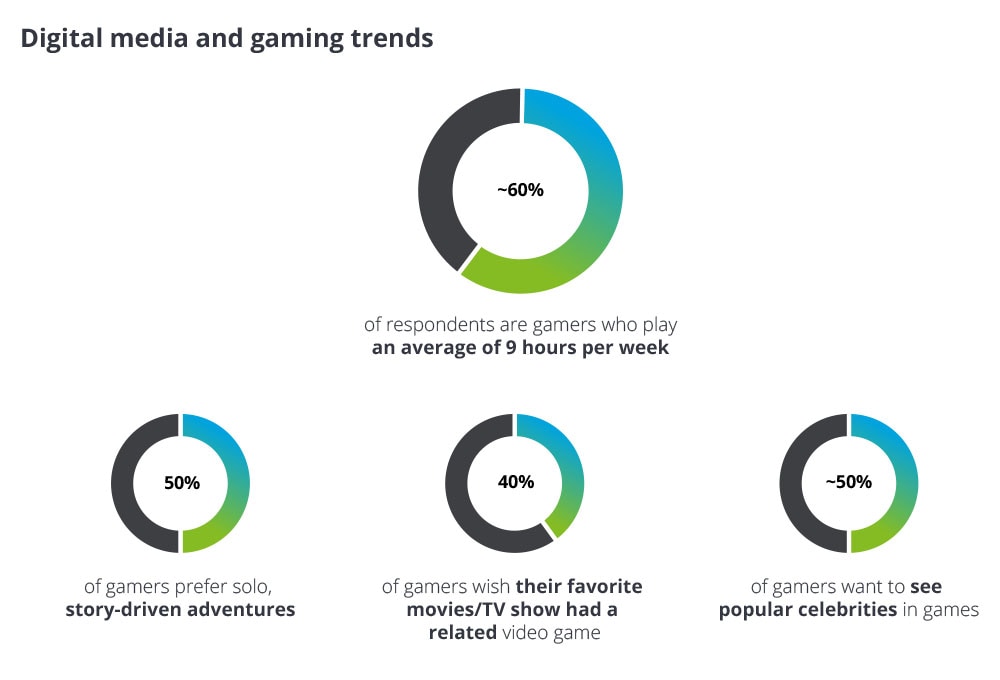M&A in gaming has been saved

Perspectives
M&A in gaming
Cross-media opportunities
Fans are seeking more crossover engagement with media franchises, making strong intellectual property (IP) even more critical for gaming companies. But when it comes to increasing fan engagement and expanding content, when does it make sense to build, buy, or borrow?
The rise of IP-based gameplay
Digital media consumption is undergoing a transformation, pushed by younger generations who are spreading their engagement across a wider mix of media while seeking more interconnected and immersive experiences. And video games are an important part of that mix.
As companies in the gaming industry seek to add new players and foster deeper engagement and loyalty among existing players, cross-media opportunities may play a crucial part in their strategy. HBO’s The Last of Us,1 a TV show adaptation of the game by the same name; Hogwarts Legacy,2 a game based on the Harry Potter universe; and Amazon’s Fallout,3 the second most-watched title ever on Prime video based on the game by the same name, are just three of the many recent examples of success with this approach.

In this year’s Digital Media Trends survey, approximately 60% of respondents were gamers who play an average of nine hours per week. Across all gamers surveyed, there’s a desire for strong IP-based gameplay:
- 50% of gamers prefer solo, story-driven adventures
- 40% of gamers wish their favorite movies/TV shows had a related video game
- Nearly 50% of gamers want to see popular celebrities in game
These cross-media opportunities are often important in capturing fan engagement. The survey also found that 41% of Gen Z and 35% of millennial respondents report their favorite video game fandom is an important part of their identity. They’re also more likely to have paid video game subscriptions and play more hours per week than casual gamers.
As fans seek more crossover engagement with their favorite media franchises, strong IP is expected to continue to become ever more crucial for gaming companies. But developing that IP can be challenging. Companies that try to adopt a build-first strategy to develop IP from the ground up may fall behind their competitors. Alternatively, companies can borrow or buy the IP or capabilities they may need to help meet their strategic objectives.
Borrowing IP from other media companies
Companies can borrow content or IP through licensing agreements, partnerships, or joint ventures. This approach is typically quicker to achieve but is often more limited in scope. It can be ideal for two companies that have complementary assets, one with strong IP and the other with strong gaming experience. Examples include:
- Licensing: A gaming licenses IP from a movie franchise for in-game content or development of a full game.
- Strategic partnership: A large sports league invests in a game company to develop a gaming universe based on the league’s sport and athletes.
- Joint venture: A hardware manufacturer and gaming company form a joint venture to develop a video game exclusive to a hardware platform.
Buying capabilities through acquisitions
Companies can buy capabilities or IP through mergers or acquisitions. This approach is often more complex, generally takes a longer time to achieve, and can come with higher risks. Factors like available cash and debt capacity, along with market capitalization, can limit scope. However, buying can give the acquirer full control over the assets. Examples include:
- IP acquisition: A gaming company purchases IP rights to develop a video game series.
- Capabilities acquisition: An entertainment studio acquires a game developer to bring video game development based on their franchises in-house.
Want to learn more about gaming M&A opportunities? Connect with our team:
Endnotes
1 Television Academy Emmys, “’The Last of Us’ – 2023 awards and nominations,” accessed June 2024.
2 Jennifer Maas, “‘Hogwarts Legacy’ earns $850 million, sells more than 12 million units in first two weeks,” Variety, February 23, 2023.
3 Joe Otterson, “‘Fallout’ nabs 65 million viewers in first two weeks of availability, Amazon claims,” Variety, April 29, 2024.




